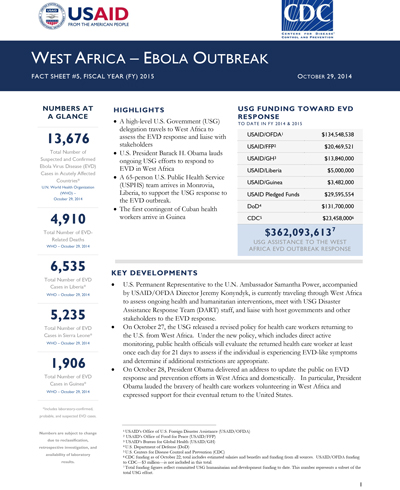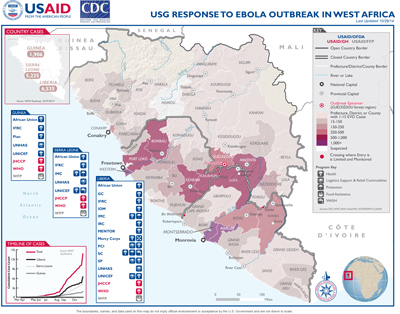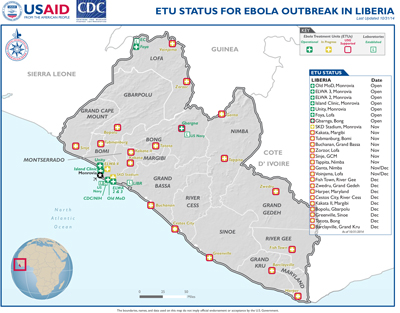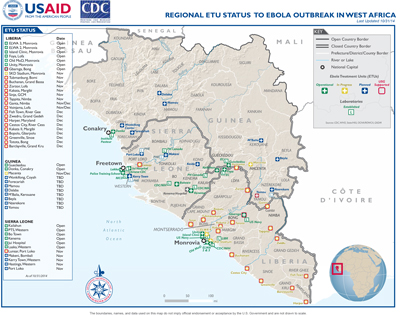Speeches Shim
October 29, 2014
HIGHLIGHTS
Ebola Response
Visit our main West Africa Ebola Outbreak page to learn more about how we're responding to the West Africa Ebola outbreak, and what you can do to help.
- A high-level U.S. Government (USG) delegation travels to West Africa to assess the EVD response and liaise with stakeholders
- U.S. President Barack H. Obama lauds ongoing USG efforts to respond to EVD in West Africa
- A 65-person U.S. Public Health Service (USPHS) team arrives in Monrovia, Liberia, to support the USG response to the EVD outbreak.
- The first contingent of Cuban health workers arrive in Guinea
West Africa - Ebola Outbreak - Fact Sheet #5 (FY 15) ![]() (pdf - 277k)
(pdf - 277k)
KEY DEVELOPMENTS
- U.S. Permanent Representative to the U.N. Ambassador Samantha Power, accompanied by USAID/OFDA Director Jeremy Konyndyk, is currently traveling through West Africa to assess ongoing health and humanitarian interventions, meet with USG Disaster Assistance Response Team (DART) staff, and liaise with host governments and other stakeholders to the EVD response.
- On October 27, the USG released a revised policy for health care workers returning to the U.S. from West Africa. Under the new policy, which includes direct active monitoring, public health officials will evaluate the returned health care worker at least once each day for 21 days to assess if the individual is experiencing EVD-like symptoms and determine if additional restrictions are appropriate.
- On October 28, President Obama delivered an address to update the public on EVD response and prevention efforts in West Africa and domestically. In particular, President Obama lauded the bravery of health care workers volunteering in West Africa and expressed support for their eventual return to the United States.
CURRENT SITUATION
Although the overall EVD response continues to scale up, affected countries in West Africa still lack comprehensive information regarding the volume and location of new cases across the region. On October 28, the U.N. Mission for Ebola Emergency Response (UNMEER) Head Tony Banbury noted that strong, reliable information on EVD transmission remains lacking in many areas, thereby impeding efforts to hone and better target health interventions, international media report. To help gather data on the EVD outbreak and inform the USG response, CDC has positioned approximately 83 epidemiologists in Liberia, Sierra Leone, and Guinea. Further, the DART has positioned information officers throughout acutely affected countries to gather data and improve intra-USG reporting.
Liberia
On October 27, a 65-person USPHS team arrived in Monrovia to support the USG response to the EVD outbreak. The USPHS team plans to staff the 25-bed Monrovia Medical Unit (MMU), an EVD treatment unit (ETU) designated to provide treatment to health care workers who contract EVD. The team completed extensive training with CDC before departing the U.S., and plans to participate in additional training in Monrovia prior to providing care at the MMU.
On October 28, Ambassador Power and Director Konyndyk arrived in Liberia. The delegation met with partner representatives, other USG actors, and key GoL officials—including President Ellen Johnson Sirleaf—to assess ongoing EVD response efforts. The delegation toured the DoD-supported MMU and met with USPHS Commissioned Corps officers who will staff the facility. Following the MMU tour, Joint Force Commander (JFC) Major General Gary Volesky joined the delegation’s visit to the U.S. Navy-supported mobile laboratory at Bong County’s Cuttington University and the USAID/OFDA-funded, International Medical Corps (IMC)-run ETU nearby.
As of October 22, more than 2,200 EVD response workers are actively conducting contact tracing in Liberia, according to the GoL. Challenges to implementing contact tracing include inadequate resources to fund contact tracing activities, delays in reporting cases and contacts, and underreporting contacts. USAID/OFDA is currently supporting multiple non-governmental organizations (NGOs) to conduct contact-tracing trainings and activities throughout Liberia.
The Liberian Red Cross Society (LRCS) announced on October 28 that the number of EVD-infected cadavers collected by its Monrovia-based dead body management teams have decreased in recent days, international media sources report. The LRCS reported collecting 117 bodies in Montserrado County—which includes Monrovia—in late October. This figure is a significant decline from the 315 bodies LRCS gathered between September 15 and 21. Despite this positive trend, LRCS still urges adherence to infection control practices and efforts to curb EVD. Further, WHO continues to warn that EVD transmission remains high in Liberia.
CDC incident management experts and the DART continue to work to expand Liberia’s emergency management capacity by establishing a permanent emergency operations center (EOC) facility in Monrovia. The permanent facility is intended to enable MoHSW to manage current and future public health emergencies. The existing national-level EOC continues to operate with significant USG support, including CDC technical assistance, and currently serves as a hub for the national-level EVD outbreak response.
During a recent visit to Grand Kru County’s Parloken town, a CDC epidemiologist observed an urgent need to establish an isolation facility. CDC staff mobilized the GoL, WHO, UNICEF, and eHealth Africa to rapidly deploy supplies, materials, essential medicines, and a technical team to the area to establish the facility. The interagency team plans to train and monitor local community health workers to provide safe patient triage and care in the new facility. CDC plans to develop standard operating procedures and guidelines for rapid deployment of isolation facilities in EVD hotspots in remote areas of Liberia, and will work with DART counterparts to identify potential partners.
More than $1.3 million in USAID/OFDA FY 2015 funding is enabling partner Welthungerhilfe (WHH) to build four ETUs in Liberia, one each in Grand Gedeh, Maryland, Sinoe, and River Gee counties. These facilities, combined with ETUs constructed by DoD, account for the additional 17 ETUs pledged by the USG for Liberia.
Sierra Leone
While in Sierra Leone, Ambassador Power and Director Konyndyk met with representatives from the U.S. Embassy, the Government of Sierra Leone (GoSL), the U.K., U.N. agencies, NGOs, as well as DART and CDC staff to discuss response activities and challenges. The delegation also visited the recently-established National Ebola Response Center, the Western Area Burials Command Center, and the training center at the national stadium, all efforts supported by the U.K. Ambassador Power noted the positive impact of safe burials and social mobilization, in addition to treatment beds, at stemming the advance of the outbreak in Kailahun and Kenema districts.
The DART reports six operational ETUs in Sierra Leone, with the U.K. Department for International Development (DFID) reporting that its five supported ETUs are under construction and progressing as planned. A USAID/OFDA-funded, IMC-run ETU in Lunsar town, Port Loko District is expected to complete construction in early November and become operational by mid-November. The 50-bed ETU will initially support 10-15 beds, with plans to increase the number of beds every two weeks.
The GoSL reported on October 26 plans to open a 100-bed ETU in Port Loko town. The planned facility will serve as both a holding and treatment center, and will likely be partially staffed by Cuban medical personnel in addition to Sierra Leonean health staff. In the coming weeks, two additional ETUs in Port Loko District—one Lunsar town and another in Port Loko town—are planned to begin operations, according to the GoSL.
WHO is currently constructing four community care centers (CCCs) in Port Loko District, and plans to complete the sites by the end of October. Once constructed, NGOs will staff and operate the CCCs, and WHO will provide technical assistance.
CDC—in conjunction with DFID and the GoSL’s Ministry of Health and Sanitation—is providing expertise and personnel to develop a standardized reporting template and improve laboratory procedures and surveillance information. A technical working group and Laboratory Coordination Center will develop standard procedures and guidelines for the critical pre- and post-analytic areas of laboratory testing, such as notification, collection, distribution, testing, results validation, and communication of results.
Guinea
While in Guinea, Ambassador Power met with NGOs, including USAID/OFDA partners, to discuss response challenges and gauge community and civil society perspectives on the EVD outbreak and response. Ambassador Power reported that the USG is encouraging other international donors to take the lead on the EVD response in Guinea, while noting that the USG will continue to scale up its support to response efforts in Guinea.
In recent days, the first cohort of Cuban medical personnel arrived in Conakry, Guinea, to assist the EVD response. The staff, primarily epidemiologists, are establishing testing laboratories in various areas of high EVD transmission. The arrival of additional health staff is timely, as some areas of Guinea are experiencing a sharp increase in EVD caseload.
From October 1–24, the Government of Guinea (GoG) Ministry of Health and other EVD response actors reported 374 EVD cases—including 215 EVD-related deaths—in Guinea, the highest monthly total recorded since the beginning of the outbreak.
According to DART conversations with WHO, overall EVD response efforts in Guéckédou and N’Zérékoré prefectures are helping to control the outbreak in these areas. However, the EVD caseload in Macenta Prefecture remains a major concern. Ongoing contact tracing and community sensitization activities are insufficient to meet current needs. Community-level resistance to EVD intervention continues in Macenta, including in areas that have no reported EVD cases to date, according to the meeting participants.
On October 26, the Government of France (GoF) deployed 30 French trainers to Guinea to train 200 Guineans in first aid and EVD response procedures, according to GoF press releases.
The GoG recently procured 24 additional vehicles to provide ambulance and other EVD response services in Guinea. On October 24, the GoG—with support from the Guinea Red Cross—dispatched eight of the vehicles to support activities in Beyla, Lola, and Yomou prefectures.
CDC reports that the GoG plans to expand the CDC-developed contact-tracing model, which has proved successful in Conakry, to other areas of the country in an effort to reduce EVD transmission rates. CDC supported the development of the contact-tracing model in Guinea, which consists of triaging, testing, and isolating cases, as well as providing technical assistance and scientific input to generate exhaustive lists of contacts from all EVD cases.
Mali
On October 23, the Government of Mali (GoM) confirmed that a Guinean child traveling through southern Mali tested positive for EVD. WHO reports that while traveling by bus from Guinea to Mali, the child was symptomatic, potentially posing infection risk to multiple people. Upon arrival in Kayes town, local health officials hospitalized the patient. She died on October 25.
Prior to the confirmed existence of EVD in Mali, the GoM, CDC, the U.S. Embassy in Bamako, and other international stakeholders had conducted EVD preparedness activities. Further, the U.N. appeal for the EVD response had identified Mali as one of West Africa’s priority countries for EVD preparedness. As a result, the GoM—in partnership with UNICEF, the High Islamic Council, WHO, and other partners—immediately launched community awareness and contact tracing activities, isolating at least 82 persons with known contact with the index case as of October 28.
A USAID/OFDA staff member based in Mali is closely following events in Mali and liaising with USG counterparts—including CDC—working on the regional EVD response.
LOGISTICS AND RELIEF COMMODITIES
At the request of WHO, the U.N. World Food Program (WFP) is constructing two ETUs in Monrovia to treat EVD, the U.N. reports. WFP-recruited engineers and logisticians collaborated with medical experts from Médecins Sans Frontières and WHO to design the facilities, including installing more than 30,000 square meters of sewage and water infrastructure and procuring 33 large storage tents and generators. In the coming days, WFP plans to transfer complete management of the ETUs to WHO. Following rain-related delays, WFP began construction on an ETU in N’Zérékoré, Guinea, on October 27.
In response to the emergent EVD case in Mali, the U.N. Humanitarian Air Service (UNHAS) dispatched one metric ton of medical supplies from Monrovia to Bamako on October 25, the U.N. reports. The cargo included PPE, gloves, face shields, and buckets.
UNMEER began conducting regular flights between Conakry, Sierra Leone’s capital city of Freetown, Monrovia, and Ghana’s capital city of Accra, in recent days.
FOOD SECURITY AND LIVELIHOODS
A late October remote monitoring survey by WFP indicated that southeastern Guinea is increasingly vulnerable to food insecurity. The assessment, which evaluates the frequency and severity of household coping strategies in the face of a crisis, identified Macenta Prefecture as particularly vulnerable deteriorating food security. Typical household coping strategies include reducing the quality and frequency of meals. Forest Region, southeastern Guinea, reported many households with adults limiting their own food consumption in favor of feeding their children.
In late October, the NGO Christian Aid began delivering emergency food assistance and hygiene kits to families in areas of Sierra Leone acutely affected by EVD. Christian Aid is targeting more than 2,100 quarantined people in eastern Kailahun District and Waterloo, a suburb of Freetown. The food kits include cooking oil, canned fish, rice, onions, and powdered milk.
INTERNATIONAL RESPONSE
At the European Council meetings in Brussels on October 23 and 24, European nations pledged to increase financial assistance to support EVD response by raising total funding to €1 billion—approximately $1.3 billion. In addition, Prime Minister of the U.K. David Cameron announced as part of this commitment, the Government of the U.K. (GoUK) has increased its own support for the EVD response in West Africa by £80 million—approximately $128 million—bringing total GoUK contributions to more than £200 million. The additional GoUK funding will increase the number of safe burial teams in Sierra Leone, as well as support the creation of up to 200 CCCs throughout the country and to support the U.N. Trust Fund.
The Government of Nigeria (GoN) has pledged to send up to 600 medical volunteers to EVD-affected countries in West Africa to help combat the virus, according to media sources. The health workers have previous training in EVD containment; the GoN reported plans to deploy an initial 250-person contingent to unspecified areas in the coming weeks. The pledge follows WHO’s October 20 announcement that Nigeria is officially free of Ebola.
PUBLIC DONATION INFORMATION
- The most effective way people can assist relief efforts is by making cash contributions to humanitarian organizations that are conducting relief operations. A list of humanitarian organizations that are accepting cash donations for disaster responses around the world can be found at www.interaction.org.
- USAID encourages cash donations because they allow aid professionals to procure the exact items needed (often in the affected region); reduce the burden on scarce resources (such as transportation routes, staff time, and warehouse space); can be transferred very quickly and without transportation costs; support the economy of the disaster-stricken region; and ensure culturally, dietary, and environmentally appropriate assistance.
More information can be found at:
- The Center for International Disaster Information: www.cidi.org or +1.202.821.1999.
- Information on relief activities of the humanitarian community can be found at www.reliefweb.int.
USAID/OFDA bulletins appear on the USAID website at what-we-





Comment
Make a general inquiry or suggest an improvement.